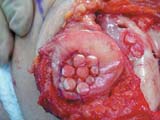Cartilage transplants resulted in improved knee function
Patients younger than 35, those with a BMI less than 25 and those with autograft had the best results.
![AOSSM Quebec [logo]](/~/media/images/news/print/orthopedics-today/2004/08_august/aossm_145_53_1757.gif) Allograft or autograft
osteoarticular transplants are useful tools for treating full-thickness
articular cartilage lesions of the knee, according to a prospective analysis of
43 patients.
Allograft or autograft
osteoarticular transplants are useful tools for treating full-thickness
articular cartilage lesions of the knee, according to a prospective analysis of
43 patients.
“The current data support the use of refrigerated allograft or mosaicplasty for fairly large cartilage lesions. We saw statistical improvement at 36 months in KSCRS (Knee Society Clinical Rating System) and WOMAC scores; however, long-term follow-up is certainly necessary,” said Albert W. Pearsall IV, MD, of the University of South Alabama Medical Center in Mobile.
Between 1998 and 2001, 64 patients with large single or multiple full-thickness defects that failed conservative treatment underwent transplantation with autograft or refrigerated or frozen allograft cartilage.
Forty-three patients met the criteria for three-year follow-up (range, 24 to 60 months). Twenty-three patients were men; average age, 44.7; average BMI was 31.4 kg/m2. The average total defect area was 10.2 cm2; majority of the defects (55%) were on the medial femoral condyle.
 |
 |
 |
|
The intraoperative views of the distal femur (top) and trochlea and patella (middle) after refrigerated allograft transplantation are seen here. The intraoperative view of the patella after autologous mosiacplasty (bottom). COURTESY OF ALBERT W. PEARSALL IV |
||
Autograft transplants
Autograft transplantations were performed arthroscopically for defects less than 2.54 cm2. Defects were filled with 6-mm and 10-mm plugs harvested from the medial lateral femur and the intercondylar notch. No plugs were harvested from the contralateral knee. The grafts were press-fit and the plugs were oriented perpendicular to the articular surface; 21 patients were treated with autograft, Pearsall said.
Allograft transplantations were performed for patellar and trochlear defects using a mini-arthrotomy and an elevated tibial osteotomy. Single or multiple plugs at least 18 mm in diameter were placed press-fit flush with the surface; 13 patients received fresh allograft and nine received frozen. Less than 50% of patients could be treated as outpatients and had to stay two or three days. Continuous passive motion was begun on the first day.
“When we looked at the defect size and analyzed the relationship to graft type, there was a statistically significant difference between autograft and frozen allograft and also between autograft and refrigerated allograft,” Pearsall said. Post hoc analysis showed improvements (P,.05) in pain, stiffness and function scores in patients younger than 35, those with a BMI less than 25 and those who received autograft when compared to patients older than 35, those with a BMI greater than 30 and those who received an allograft.
Failure rates
|
There was a failure rate of 17%, cases in which patients had to go on to unicondylar or total knee arthroplasty. In one patient, a screw backed out so the technique was changed to make all transplants press-fit. “We looked at extreme analysis from the failures and the group results were analyzed; however, we found no significant relationship for any of those variables.”
Pearsall said limitations of the study include the small number
of patients, lack of a control group, relatively
early follow-up and the
non-inclusion of a recently developed loading procedure. “Future work
might want to evaluate improved chondrocyte viability during storage if
allografts are going to be used and also analyze outcome analysis vs. the
viability at the time of implantation.”
For more information:
- Pearsall AW, Madanagopal SG, Kovaleski JE, Hughey J. Osteoarticular autograft and allograft transplantation of the knee: three-year follow-up evaluation. Presented at the American Orthopaedic Society for Sports Medicine 2004 Annual Meeting. June 24-27, 2004. Quebec.
